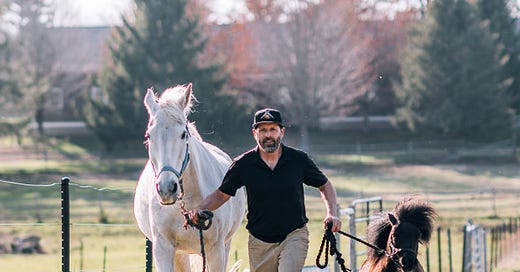Hunter experienced a health scare last week when he choked on his grain. When I arrived at the barn, I found a crowd gathered around his stall. A volunteer was holding a twitch on Hunter’s nose, while a veterinarian was using a plastic tube to relieve the grain block in his throat. Hunter stood still, heavily sedated.
I made my way through the onlookers to speak directly with the veterinarian about Hunter's recent appointment with the equine dentist a few days earlier. After the vet successfully removed the blockage, a collective sigh of relief went up from those present.
This is the reality of caring for horses. Unexpected situations arise, and we do our best as humans to make informed decisions based on the information available. However, it’s important to recognize that no one is perfect. Fortunately, Hunter pulled through this incident. Life goes on for us, and it serves as a learning experience for some, while others may not take away the same lessons.
After the crisis, I called the vet’s office to express my gratitude, especially since he had come out on Easter Sunday. Given the limited information about Hunter’s background, I asked the assistant if she had a record of his birthdate. She informed me that Hunter was born on January 1, 1994. Wait? What did you say? I called her back to confirm, and she reassured me that the information was correct.
This means Hunter is actually thirty-one years old, NOT the twenty-five years most of us had assumed! He is an old horse!
Note: Thoroughbreds are assigned a standardized birthday of January 1 for several reasons, primarily centered around the organization and regulation of horse racing. This practice allows for a uniform age designation, making it easier to categorize and compare horses across races.
The average life expectancy for horses usually ranges from twenty-five to thirty years. While many agree that Hunter looks younger than his age, certain realities remain—he has severe arthritis in his hocks, many of his teeth have expired, and his muscle tone continues to lessen.
Hunter is a survivor, deemed a “valueless” horse, just like Romeo, his friend and colleague. Romeo has a different story; he was purchased at an auction, which is often the final stop before horses are sent to slaughter. There are no records of Romeo's past, but his current owner has assigned him a birth date of January 1, 2014, making him eleven years old.
Have you ever heard the phrase "long in the tooth"? It’s an idiom that means someone or something is aging or past its prime. The expression is believed to have originated in horse racing, as a horse's gums recede over time, making their teeth appear longer. To determine a horse's age without knowing their birthdate, you can examine various physical characteristics, particularly the teeth. Horses have a defined dental development timeline; for instance, they typically get their first full set of adult incisors around the age of five. As they age, the wear on their teeth increases due to the grinding of food.
In summary, the exact ages of Hunter and Romeo remain uncertain. It is clear that Hunter is a senior horse, while Romeo is a healthy, middle-aged miniature horse with a life expectancy of thirty to thirty-five years.
Does age matter? To some extent, yes.
Here are two important points to consider:
1. Horses do not concern themselves with our man-made constructs of time and calendars.
2. Horses that move consistently tend to fare better than those that are confined and restricted.
When I first met Hunter, he could barely trot due to back pain, inflammation, and arthritis. At the same time, Romeo was significantly overweight, carrying an extra 40 pounds. Both horses desperately needed movement. I introduced them to groundwork exercises and training, centered on one crucial element: offering them love and kindness.
Initially, both horses were shut down, depressed and disinterested. I began working with Hunter individually. I quickly realized that he was unhappy and stressed in the indoor arena without any companions. Shortly thereafter, I invited Romeo to join our sessions.
This change yielded immediate success! Hunter now had a role, teaching Romeo to listen and respond. Romeo, in turn, was enthusiastic about participating, and depending on Hunter’s wisdom.
As a result, Hunter began to move more freely. Soon, the three of us ventured on trail walks together, incorporating trotting into our routine. In this dynamic, Hunter charged the trails like he did in his younger years, while Romeo provided support, helping to ground Hunter’s anxious energy. It became a mutually beneficial exchange.
Like all the horses I have encountered and worked with, I have learned to adapt to their energy and needs. Together, the three of us are unique companions. While many of my peers are managing mortgages, raising children, and working out at health clubs, I am spending my time running with horses in the mud, snow, and rain.
Hunter, Romeo, and I have found a way to define time on our own terms. The past is behind us, and the future is yet to come. We remain three timeless misfits, not ready to act our age.
Camron Adibi is an Equine Therapist and a PATH Certified Therapeutic Riding Instructor, holding a master's degree in education from Gordon College. He specializes in guiding children to reconnect with themselves and others through meaningful, nonverbal interactions with horses. By tapping into the emotional intelligence of horses, children cultivate emotional resilience and boost their confidence. They learn to regulate their emotions, trust their instincts, and more comfortably express their true selves. In a calm and supportive environment, children gain a deeper understanding of themselves, develop healthier relationships, and navigate a world that can often feel overwhelming. This work focuses not on riding but on building connection. Through gentle and grounded experiences, children discover their voice, build trust, and step into their full potential. www.camronadibi.com




